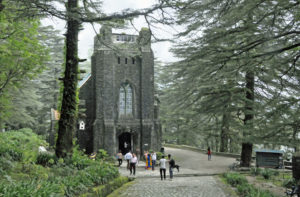
Church of St. John in the Wilderness (Photo by Don Knebel)
The town of McLeod Ganj lies almost 7000 feet above sea level in the Dhauladhar Mountains of northern India, a few miles north of Dharamsala. In the nineteenth century, McLeod Ganj became a hill station, where British troops in the area could escape the summer heat. In 1852, an Anglican church was built for the troops amid the cedar trees along the road from Dharamsala to McLeod Ganj. The Gothic church, remembering John the Baptist, became known as the Church of St. John in the Wilderness. The church and its trees were a favorite spot for James Bruce, the 8th Earl of Elgin, who became Governor-General and Viceroy of India in 1861. When Bruce died in Dharamsala in 1863 at age 52, he was buried, as he had requested, on the church grounds. His widow erected a stone monument in his memory behind the church and donated magnificent stained glass windows from Belgium, with images of Jesus and John the Baptist, for the church building.
In 1905, the powerful Kangra earthquake destroyed most of Dharamsala and McLeod Ganj, killing 20,000 people. The church survived, without its bell tower and spire. In 1915, Mears and Stainbank, the London foundry that cast the Liberty Bell and Big Ben, created a new bell that was too large to be hung inside. The bell now rests in a cage on the church grounds. A cemetery nearby contains graves of British soldiers and residents killed in the earthquake.
The Church of St. John in the Wilderness is easy to miss in the haste to get to McLeod Ganj. A visit is worth the short delay.